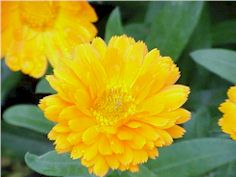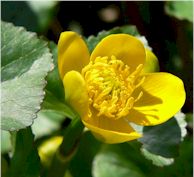
Corn Marigold |

Garden Marigold |

Mareblobs |
In the "Grete Herball" this plant was called Mary Gowles. Three varieties of the Marigold exercise medicinal virtues which constitute them Herbal Simples of a useful nature--the Corn Marigold (Chrysanthemum segetum), found in our cornfields; the cultivated garden Marigold (Calendula officinalis); and the Marsh Marigold (Caltha palustris), growing in moist grass lands, and popularly known as "Mareblobs."
The Corn Marigold, a Composite flower, called also Bigold, and the Yellow Oxeye, grows freely, though locally, in English cornfields, its brilliant yellow flowers contrasting handsomely with adjacent Scarlet-hued Poppies and Bluebottles (Centaurea cyanus). It is also named Buddle or Boodle, from buidel, a purse, because it bears gools or goldins, representing gold coins, in the form of the flat, round, brightly yellow blossoms, which
were formerly known, too, as "Ruddes" (red flowers). The botanical title of the species, "Chrysanthemum segetum", signifies "golden flower."
Hill named this Marigold, "the husbandman's dyall." In common with the larger Oxeye Daisy (Chrysanthemum leucanthemum) it has proved of late very successful in checking the night sweats of pulmonary consumption. A tincture and an infusion of the herb have been made; from five to ten drops of the former being given for a dose, and from two to three tablespoonfuls of the latter.
The garden Marigold, often called African Marigold, came originally from Southern France, and has been cultivated in England since 1570. It is a Composite plant, and bears the name "Calendula" from the Latin calendoe, the first days of each month, because it flowers all the year round. Whittier styles it "the grateful and obsequious Marigold." The leaves are somewhat thick and sapid; when chewed, they communicate straightway a viscid sweetness,
which is followed by a sharp, penetrating taste, very persistent in the mouth, and not of the warm, aromatic kind, but of an acrid, saline nature. This Marigold has always been grown, chiefly for its flowers, which were esteemed of old as a cordial to cheer the spirits, and when dried were put into broths as a condiment: Charles Lamb (Elia) says, in his "Essay on Christ's Hospital": "In lieu of our half-pickled Sundays, or quite fresh boiled beef on Tuesdays (strong as
caro equina), with detestable Marigolds floating in the pail to poison the broth." The strap-like florets of the rays are the parts of the flowers used for such a purpose. They should be gathered on a fine day when the blossoms are fully expanded, which having been divested of their outer green leaves, should be next spread on a cloth in an airy room to become dry. After having been turned frequently for a few days, they may be put by in paper bags or in drawers.
Gerard says: "The yellow leaves of the flowers are dried and kept throughout Dutch-land against winter, to put into broths and physical potions, and for divers other purposes, in such quantity that the stores of some grocers or spice-sellers contain barrels filled with them, and to be retailed by the penny, more or less; insomuch, that no broths are well made without dried Marigolds"; and, "The herb drank after the coming forth from the bath of them that hath the yellow
jaundice doth in short time make them well colored." (This is probably conjectured on the doctrine of signatures.)
A decoction of the flowers is employed by country people as a posset drink in measles and small-pox; and the expressed fresh juice proves a useful remedy against costiveness, as well as for jaundice and suppression of the monthly flow--from one to two tablespoonfuls being taken as a dose.
The plant has been considered also of service for scrofulous children, when given to them as a salad. One of the flowers if rubbed on any part recently stung by a bee or wasp, will quickly relieve it.
Buttercups and Marigolds, when growing close to each other, are called in Devonshire, "publicans and sinners." The active, bitter principle of the Marigold is "callendulin," which is yellow and tasteless, whilst swelling in water into a transparent jelly. Druggists now make a medicinal tincture (H.) of the common Marigold, using four ounces of the dried florets to a pint of proof spirit, the dose being from half a teaspoonful to two teaspoonfuls in water, twice or three times
in the day. It is advised as a sudorific stimulant in low fevers, and to relieve spasms. Also, the Marigold has been employed both as a medicine and externally in treating cancer, being thought to "dispose cancerous sores to heal." A saturated tincture of the flowers when mixed with water, promotes the cure of contusions, wounds, and simple sores or ulcers; also the extract will allay chronic vomiting, if given in doses of two grains, several times a day. One drop of the
tincture with two grains of powdered borax when sprayed into the ear, is very useful if a discharge has become established there from.
The plant, especially its flowers, was used on a large scale by the American surgeons, to treat wounds and injuries sustained during the last civil war; and obtained their warmest commendation. It quite prevented all exhausting suppurative discharges and drainings. "Succus Calenduloe" (the fresh juice) is the best form--say American surgeons--in which the "Calendula" is obtainable for ready practice. Just sufficient alcohol should be added to the juice as will prevent
fermentation. For these purposes as a vulnerary, the Calendula owes its introduction and first use altogether to homoeopathic methods, as signally valuable for healing wounds, ulcers, burns, and other breaches of the skin surface. Dr. Hughes (Brighton) says: "The Marigold is a precious vulnerary. You will find it invaluable in surgical practice."
On exposure to the sun the yellow color of the garden Marigold becomes bleached. Some writers spell the name "Marygold," as if it, and its synonyms bore reference to the Virgin Mary; but this is a mistake, though there is a fancied resemblance of the disc's florets to rays of glory. It comes into blossom about March 25th (the Annunciation of the Virgin Mary).
"What flower is this which bears the Virgin's name, And richest metal joined with the same?"
In the chancel of Burynarbon Church, Devonshire, is an epitaph containing a quaint allusion to this old idea respecting the Marigold:--"To the pretious memory of Mary, ye dear, and only daughter of George Westwood. January 31st, 1648."
"This Mary Gold, lo! here doth show
Mari's worth gold lies here below;
The Marigold in sunshine spread,
When cloudie closed doth bow the head."
Margaret of Orleans had for her device a Marigold turning towards the sun, with the motto, "e ne veux suivre que lui seul."
Dairy women used to churn the petals of the Marigold with their cream for giving to their butter a yellow color.
The Marsh Marigold (Caltha poetarum) or the Marsh Horsegowl of old writers, grows commonly in our wet meadows, and resembles a gigantic buttercup, being of the same order of plants (Ranunculaceoe). The term, Marsh Marigold, is a pleonasm for Marigold, which means of itself the Marsh Gowl or Marsh Golden Flower, being an abbreviation of the old Saxon mear-gealla. So that the term "Marsh" has become prefixed unnecessarily. Presently, the name
"Marigold," "Marsh Gowl," was passed on to the "Calendula" of the corn fields of Southern Europe, and to the garden Marigold. Furthermore, the botanical title, Caltha, of the Mare Blob, is got from calathus, a small round basket of twigs or osiers made two thousand years and more ago, which the concave golden bowl of the Marsh Marigold was thought to resemble. Persephone was collecting wild flowers in a Calathus when carried off by the admiring Pluto. The earliest use
of the floral name "Caltha" occurs in Virgil's second Pastoral, "Mollia luteol?pingit vaccinia Calth?" The title Mare Blob comes from the Anglo-Saxon, "mere" (a marsh), and "bleb" or "blob" (a bladder). These flowers were the flaventia lumina Calthoe of Columella, described by Shakespeare in the "Winter's Tale". They are also known as "Bublicans," "Meadowbrights," "Crazies," "Christ's Eyes," "Bull's Eyes," "May Blobs," "Drunkards," "Water Caltrops," and
wild "Batchelor's Buttons." A tincture is made (H.) from the whole plant when in flower, and may be given with success for that form of bloodlessness with great impairment of the whole health, known as pernicious anaemia. In toxic quantities the marsh Marigold has produced in its provers, a pallid, yellow, swollen state of the face, constant headache and giddiness, a thickly-coated tongue, diarrhea, a small rapid pulse sometimes intermittent, heaviness of the limbs, and an
unhealthy, eruptive state of the skin; so that the tincture of the plant in small, well-diluted doses will slowly overcome this totality of symptoms, and serve to establish a sound state of restored health. Five drops of the tincture diluted to the third strength should be given three times a day with water. Dr. Withering tells that on a large quantity of the flowers being put in the bed-room of a girl subject to fits, the attacks ceased; and an infusion of the flowers has
been since given with success for similar fits.
The Marsh Marigold has been called Verrucaria, because efficacious in curing warts; also Solsequia, or Solsequium; and Sponsa Solis, since the flower opens at the rising, and shuts at the setting of the sun.
Herb Simples
The Primitive Simplers presented here show the way of life in other generations, it is not suggested or recommended trying them yourself. |
|
Garden
Herbs
Home
History of Herbs
Herb Gardening
Herbs for Beginners
Drying & Preserving Herbs
Indoor Herb Gardening
Herb Garden
Hints & Tips
Herbal
Cooking
Herb Chart
Using Herbs
Culinary Herbs
Herb
Oil and Vinegar
Herb Teas
Herb Candy
Herb Jelly
Herb Simples
Preface
Introduction
Alphabetical Listing

Trade
Recipes Online
Share your Recipes with others!!
|




